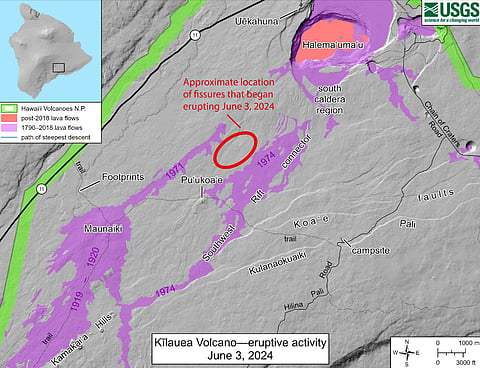The alert levels in Hawaii Volcanoes National Park have been raised following the eruption of Kīlauea volcano early Monday morning in an area that hasn't seen an eruption for nearly five decades.
Hawaii's Kīlauea Erupts After 50 Years, Map Shows Area Of Fissure: Hawaii Volcanoes National Park On High Alert
Hawaii's Kīlauea volcano has erupted after a 50-year hiatus, prompting heightened alert levels in the Hawaii Volcanoes National Park. The eruption, which began early Monday morning, has raised concerns over potential hazards such as volcanic gases and vog for nearby communities.
As per a notification from the USGS Hawaiian Volcano Observatory (HVO), the Volcano Alert Level for ground-based hazards was increased from watch to warning, and the Aviation Color Code shifted from orange to red after the new eruption began at approximately 12:30 a.m. local time (6:30 a.m. ET).
According to scientists, the eruption likely began approximately one mile south of Kīlauea caldera and north of the Koa’e fault system and Hilina Pali Road within the national park.

Webcams in the area captured a glow, indicating to scientists that lava was emanating from fissures in an area that has remained dormant since December 1974.
Although the 1974 eruption lasted only six hours, scientists caution that it's impossible to predict the duration of this current eruption.
The HVO stated that it will maintain close surveillance of Kīlauea to track any activity fluctuations and provide regular updates.

Risks linked to the ongoing eruption encompass the emission of hazardous volcanic gases, which can be dangerous to communities downwind.
Moreover, vog (volcanic smog) has been sighted in areas downwind of Kīlauea, potentially posing airborne health hazards to residents and visitors in the vicinity, as well as posing threats to crops, vegetation, and animals.

